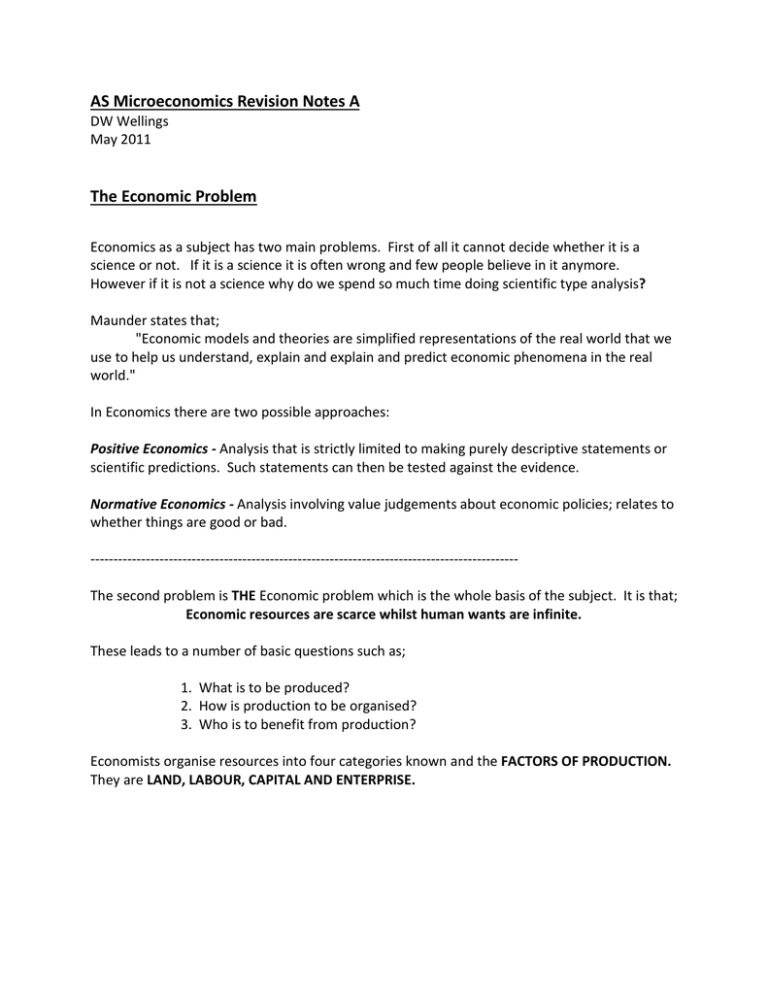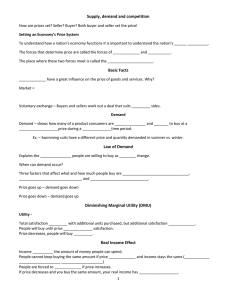AS Micro Economics Revision Notes A
advertisement

AS Microeconomics Revision Notes A DW Wellings May 2011 The Economic Problem Economics as a subject has two main problems. First of all it cannot decide whether it is a science or not. If it is a science it is often wrong and few people believe in it anymore. However if it is not a science why do we spend so much time doing scientific type analysis? Maunder states that; "Economic models and theories are simplified representations of the real world that we use to help us understand, explain and explain and predict economic phenomena in the real world." In Economics there are two possible approaches: Positive Economics - Analysis that is strictly limited to making purely descriptive statements or scientific predictions. Such statements can then be tested against the evidence. Normative Economics - Analysis involving value judgements about economic policies; relates to whether things are good or bad. --------------------------------------------------------------------------------------------The second problem is THE Economic problem which is the whole basis of the subject. It is that; Economic resources are scarce whilst human wants are infinite. These leads to a number of basic questions such as; 1. What is to be produced? 2. How is production to be organised? 3. Who is to benefit from production? Economists organise resources into four categories known and the FACTORS OF PRODUCTION. They are LAND, LABOUR, CAPITAL AND ENTERPRISE. Choices As there are limited resources in this world all individuals and institutions are compelled to make choices. One way to consider these trade-offs is in terms of opportunity cost. Opportunity cost can be defined as the highest valued alternative (in £s) that had to be sacrificed for the chosen option. Another way of describing the choice is by considering production possibility frontiers or curves. The Production Possibility Frontier showing the options when only Sheep and Wheat are produced in the Economy. w a b x Sheep y c z 1 W heat 2 3 Point w shows that you are only producing Sheep Point z shows that you are only producing Wheat Point x shows that you are producing more Sheep than Wheat Point y shows that you are producing more Wheat than Sheep FINAL POINT The line of the PPF shows the combination of goods which an economy could produce if output were maximised from a fixed amount of resources. A point within the PPF shows unemployed resources and to reach a point outside more sources have to be made available. The Demand Curve The Theory of Demand 'At higher prices a lower quantity will be demanded than at lower prices other things being equal'. Or to put it another way - as price goes up quantity demanded goes down. As price goes down quantity demanded goes up. D Price 9 5 D 3 8 Quantity The demand curve is downward sloping as it shows an inverse relationship between Quantity demanded and Price. The theory of demand examines two fundamental effects:The Substitution Effect and the Income Effect A move along the demand curve represents a change in price (CHART 1)and non price determinants cause a parallel shift in the demand curve (CHART 2). p D' D p D Chart 2 Chart 1 A D' D D q B C q The Supply Curve Supply in Economics is defined as:'The quantity of goods that sellers are prepared to sell at any given price over time'. The supply curve shows that as price increases then a greater quantity will be supplied, on the expectation that greater profits will be made. S 10 Price 5 S 1000 1800 Quantity Supplied As with the demand curve price factors represent merely a movement along the curve whilst non-price factors can shift the curve to the left or right. These non-price factors include:1. Technology Greater productive efficiency means that more goods can be produced at the same or a lower price. 2. Prices of other goods This is best explained by an example. If the price of beef increases, more cattle are raised leading to an increase in the supply of leather. 3. The Goals of Sellers If a firm makes a greater commitment to increasing profits then they are likely to increase production. 4. Government Legislation Indirect taxes (VAT) or other controls, such as anti-pollution measures, increase the costs of production and lead to an adjustment to supply. 5. Expectations If firms expect higher prices in the future they may stockpile goods and then cash in on the boom. E.g. Christmas Cards 6. The Weather Plays a crucial role in boosting or reducing supplies on an annual basis particularly in agricultural industries. Price Elasticity of Demand Price Elasticity of Demand measures the responsiveness of demand to a change in price It is calculated by using the following formulae: Change in Quantity Demanded x 100 = % Change in Quantity Demanded Original Quantity Demanded Change in Price Original Price x 100 = % Change in Price Price Elasticity of Demand = % Change in Quantity Demanded % Change in Price PRICE ELASTICITY OF DEMAND IS ALWAYS NEGATIVE - as it describes the inverse relationship revealed by the demand curve. If PeD is > 1 then demand is elastic - that is that demand will fall off significantly if there is even a slight rise in price and visa versa. If PeD is < 1 then demand is relatively inelastic - that means that there is little change in demand whatever the change in price. The Determinants of Price Elasticity of Demand The exact value of Price Elasticity of Demand is determined by a variety of factors but economists single out two factors in particular. 1. Price - The better and the more available the substitutes the higher the price elasticity. 2. Time - The longer the time period the higher the price elasticity of demand. This is because it often takes the 'market' some time to respond to a price change. Other factors Necessities have lower price elasticities than luxuries as you will demand necessities at any price. Also goods which form a relatively low proportion of expenditure have a lower elasticity than those that form a more significant proportion. Price Elasticity of Supply Price Elasticity of Supply measures the responsiveness of supply to a change in price It is calculated by using the following formula: Change in Quantity Supplied Original Quantity Supplied Change in Price Original Price x 100 = % Change in Quantity Supplied x 100 = % Change in Price Price Elasticity of Supply = % Change in Quantity Supplied % Change in Price The P.E.S can be between zero and infinity. If the P.E.S is < 1 then supply is inelastic - that is that there will be only a slight increase in supply with an increase in price. If the P.E.S is > 1 supply is elastic meaning that supply will increase significantly with an increase in price and visa versa. The Extremes in Supply Curves S' P S S Line S'S' shows a Perfectly Inelastic Supply Curve. P.E.S = 0 and a change in price will have no effect on the Quantity Supplied. S' 0 Line SS shows a Perfectly Elastic Supply Curve P.E.S = Infinity and a fall in price means that suppliers will halt production Q It was mentioned last week that all elasticities tend to change over time and the supply curve becomes more elastic as: 1. The longer the time period allowed for adjustment, the more firms figure out ways to increase production in an industry. 2. The longer the time period allowed the more resources can flow into an industry through the expansion of existing firms. Thus we talk of the long run and short run price elasticity of supply where: SHORT RUN - is defined as the time period within which no adjustment takes place. LONG RUN - is the period in which firms can fully adjust to the price change.









